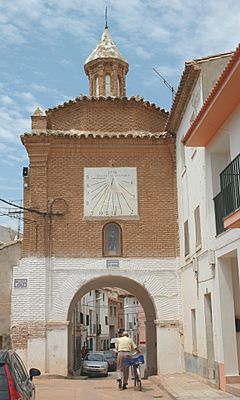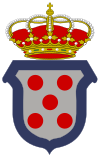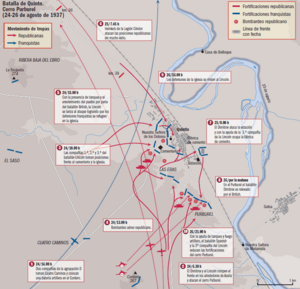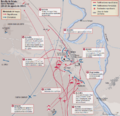Quinto, Aragon facts for kids
Quick facts for kids
Quinto
|
|||
|---|---|---|---|
|
Town and municipality
|
|||

San Roque towngate in Quinto
|
|||
|
|||
| Country | Spain | ||
| Autonomous community | Aragon | ||
| Province | Zaragoza | ||
| Municipality | Quinto | ||
| Area | |||
| • Total | 118.4 km2 (45.7 sq mi) | ||
| Elevation | 175 m (574 ft) | ||
| Population
(2018)
|
|||
| • Total | 1,948 | ||
| • Density | 16.453/km2 (42.612/sq mi) | ||
| Time zone | UTC+1 (CET) | ||
| • Summer (DST) | UTC+2 (CEST) | ||
Quinto is a town and municipality in northeastern Spain. It's located in the province of Zaragoza. You can find it on the south bank of the Ebro River. It's about 41 km southeast of Zaragoza, the capital city of Aragon. In 2017, about 1,960 people lived there. The town covers an area of 118.40 square kilometers. Quinto is also the main town of the Ribera Baja del Ebro region.
| Top - 0-9 A B C D E F G H I J K L M N O P Q R S T U V W X Y Z |
Discovering Quinto's Geography
Where is Quinto Located?
Quinto is in the Ebro Basin. It sits 175 meters (574 feet) above sea level. The town is built on old river deposits near the Ebro River. It is 42 km away from Zaragoza, the capital of the province and Aragon.
What is Quinto's Climate Like?
Quinto has a cold semi-arid climate. This means winters are a bit cold. You might see frost at night. Fog and temperature changes are common in December and January.
Summers are warm, often above 30 °C (86 °F). Temperatures can even go over 35 °C (95 °F). Nights are usually cooler than 20 °C (68 °F). A strong wind called Cierzo can blow any time, especially from October to April.
Quinto gets little rain, just over 300 mm (12 inches) each year. Most rain falls in spring and autumn. Winter and summer are dry. Snow is rare.
A Journey Through Quinto's History
How Did Quinto Get Its Name?
The name Quinto comes from the Latin word quintus. This word means "the fifth." It refers to the fifth milestone on an old Roman road. This road went from Celsa to Zaragoza. It seems the Romans set up a military post near this fifth mile marker. This is likely how the settlement began.
Quinto's Early Beginnings
In an area called Las Dehesas, near the Ebro River, there's an ancient settlement. It dates back to the Early Iron Age. This was around 750 to 500 BCE. The settlement was completely destroyed by fire. Sadly, much of the site is now gone due to railway construction.
The houses were long and rectangular. This was typical for towns in the middle Ebro Valley. People grew cereals and used hand mills. They also collected freshwater pearl mussels. This shows their economy relied on farming and raising animals. They also gathered some wild foods.
Quinto in the Middle Ages
An old writer, Pascual Madoz, said in the 1800s that a hill in Quinto was once a strong fort for the Arabs. He noted that old tower foundations were still visible. But Quinto is first mentioned in documents in 1118. This was the year it was conquered by the Christian king of Aragon, Alfonso I the Battler. In 1149, a new ditch (canal) was built. This helped new Christian settlers move in.
The first known Lord of Quinto was Atorella Ortiz. He was a friend of King Peter II. By the mid-1300s, the Barony of Quinto belonged to the Luna family. This was through marriages and inheritances. The barony included nearby towns like Gelsa and Velilla de Ebro.
Later, King Martin I gave the County of Luna to his grandson, Frederic. But Frederic rebelled, so King Alfonso V took it back in 1430. Around this time, the old Parish Church of the Assumption of Saint Mary began to be built. From 1430 until the 1600s, the Funes family owned Quinto.
Quinto in Early Modern Times
During the War of the Spanish Succession, Quinto supported the Bourbon family. Because of this loyalty, King Philip V gave Quinto the title "Most Loyal Town." Years ago, a tile on the old church said: "On the fifth day of the fifth month of the fifth year, Philip V came to Quinto." This means the king visited the town on May 5, 1705, shortly after becoming king.
Quinto in Late Modern Times
During the First Carlist War, an army led by Manuel Añón took over Quinto in December 1835. Some people who supported the queen had their homes robbed. The next year, three groups of local soldiers were formed to protect the town.
Pascual Madoz wrote about Quinto in 1845. He said it had "419 houses of little taste and comforts." These were on "11 narrow and badly paved streets, and a square for selling groceries." He also noted that Quinto had limestone quarries, a mill, oil presses, a brickyard, and bakeries. There were also clothing stores, grocery shops, and confectioners. Madoz specially mentioned the Bath House of Quinto. He wrote that it had "2 sources of salty water, whose never denied fame achieved in the past to be superstitious."
The Spanish Civil War in the 20th century greatly affected Quinto. The town became a battlefront. Many fierce fights happened there for about 14 months. On August 26, 1937, during the Battle of Belchite, Republican forces captured Quinto. This included the British Battalion from the XV International Brigade. They made Quinto their base for about seven months.
In March 1938, Franco's army took it back. The intense fighting, artillery, and air attacks almost destroyed the town. The historic church of the Assumption was badly damaged. After the war, the town was rebuilt by a special service and local people.
Quinto's Important Buildings and Places
The Church of the Assumption
The old Church of the Assumption is the most important building in Quinto. It used to be the main church. This Mudejar style temple is on a hill called "La Corona." It stands tall over the whole town. Building probably started in 1416 and finished ten years later. It seems to be built on the remains of an old Arab castle.
The church you see today has been built in different stages. Its construction is thought to be by Mahoma Ramí, an architect for antipope Benedict XIII. The church was badly damaged during the Spanish Civil War. The tower was especially hit. Because of this, a new church was built closer to the road. After the war, efforts were made to save the ruins of the old church as a historical monument.
Other Religious Buildings
Quinto has several chapels, called hermitages. Two important ones are Bonastre and Matamala. Bonastre is on a hill near the road to Castellón, about 7 km from town. The current building is Baroque style, likely from the 1700s. It was rebuilt after the Spanish Civil War.
The old Hermitage of Matamala is almost 4 km from Quinto. It's between the railway and the road to Sástago, near the Ebro River. Pascual Madoz said this temple was once a mosque. This chapel is a simple example of early Gothic style, from the 1200s. It might have been the church for the old village of Matamala. After that village disappeared, it became a hermitage around 1489. This chapel was cut off by new roads and railways. So, in 2001, a new, modern chapel was built in a different spot.
Another notable building is the old Parochial House. It stands out from the smaller, simpler houses around it. The Archbishop of Zaragoza ordered this typical Aragonese mansion to be built in 1581.
Quinto's Old Town Gates
Quinto's interesting town gates were built for defense. They are medieval in style. Their job was to protect the town's entrances. High, strong walls protected the town. These walls were formed by the backs of houses facing the outside road. The gates you see today are from the late 1600s or early 1700s.
There are three gates:
- San Miguel’s Gate was the entrance from Zaragoza.
- San Antón’s Gate led to the vegetable gardens.
- San Roque’s Gate was the exit towards Alcañiz.
Less than 4 kilometers from Quinto, near the Hermitage of Matamala, there's a hill with the last parts of Matamala castle. This castle was from the Muslim period. It seems it had a rectangular shape, about 25 by 20 meters. On the east side, you can still see the ruins of a square tower.
The "Torre de Bonastre" is a square watch tower near the Hermitage of Bonastre. It was built in the 1800s during the Carlist Wars.
Museums in Quinto
Inside the old parish church of the Assumption, you can find the first mummy museum in Spain. It's a unique place to visit!
Images for kids
See also
 In Spanish: Quinto (Zaragoza) para niños
In Spanish: Quinto (Zaragoza) para niños










